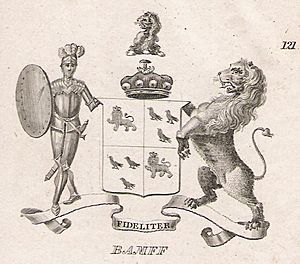George Ogilvy, 2nd Lord Banff facts for kids
George Ogilvy, 2nd Lord Banff was an important person in Scotland a long time ago. He was born around 1627 and passed away in March 1668. He was a member of the Scottish Parliament and a powerful landowner, often called a "feudal baron." He was also known as a Cavalier, which meant he strongly supported King Charles I and King Charles II during a time of big changes in Britain.
About His Family
George Ogilvy was the son of Sir George Ogilvy, 1st Lord Banff, who was the 1st Lord Banff. His mother was Janet, whose father was William Sutherland, Lord Duffus.
When his father passed away, George became the 2nd Lord Banff. On October 29, 1663, he officially inherited important lands and titles, including the areas of Inchdrewer and Mountbray. He also inherited lands in the Gamrie area on September 24, 1664.
His Role in Politics and War
Before he became Lord Banff, George was already active in Scottish politics. He represented the area of Nairnshire in the Scottish Parliament. This Parliament met in Edinburgh on June 4, 1644.
Just like his father, George was a strong supporter of the King. He stood by King Charles I and later his son, King Charles II. He even fought for King Charles II in a big battle called the battle of Worcester. George was lucky enough to escape from this battle.
His Marriage and Children
The 2nd Lord Banff, George Ogilvy, married a woman named Agnes. She was the daughter of Sir Alexander Falconer, 1st Lord Falconer of Halkerstoun.
George and Agnes had a large family with ten children. They had eight daughters and two sons. Some of their children included:
- George Ogilvy, 3rd Lord Banff (1649–1713), who later became the 3rd Lord Banff and had his own family.
- Sir Alexander Ogilvy, 1st Baronet of Forglen (1651–1727), who became a Baronet and a Member of Parliament. He also had children.
- Agnes (born 1651), who married Francis Gordon.
- Helen (around 1656 – 1714), who married Sir Robert Lauder of Beilmouth.
- Mary (born around 1657), who married John Forbes in 1680.


